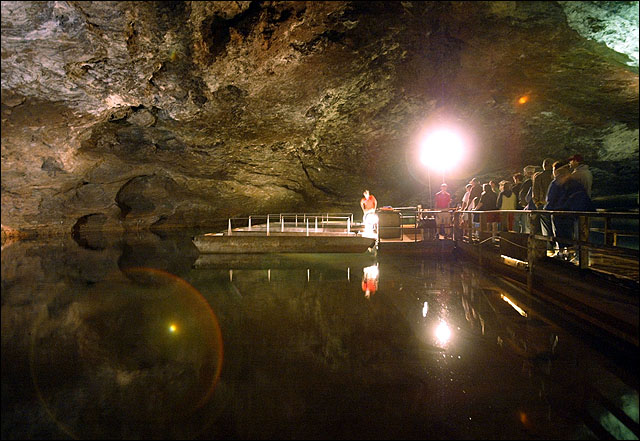Lost Sea a jewel among show caves
Tennessee cavern features world's second-largest underground lake
Sweetwater, Tenn. ? When a 13-year-old boy discovered what is now the world’s second-largest underground lake, he had to crawl through a muddy hole deep inside a cave and throw balls of dirt into the dark to discern how big the room of water was.
All he heard was the plop of mud into the water.
That was 100 years ago. The 4 1/2-acre pool of water he found about 300 feet below the cave entrance is now known as the Lost Sea, a curiosity that averages 150,000 visitors a year.
Ben Sands, the boy discoverer, returned about 60 years afterward and rode in a glass-bottom boat across it like tourists can today.
The Lost Sea has mostly been unchanged since 1965 when a group of private owners opened it as a tourist attraction. Before that it served all sorts of purposes – refrigerator, moonshine operation, meeting room, tavern, mushroom farm and saltpeter mine.
The attraction, located off Interstate 75 about 40 miles south of Knoxville, is what’s known as a show cave, meaning it’s open to the public for admission and generally has lighting and handrails. One of the most famous is Carlsbad Caverns in New Mexico, and the biggest is Mammoth Cave National Park in Kentucky.

Guests board glass-bottom boats to tour the Lost Sea in Sweetwater, Tenn. The Lost Sea is the world's second-largest underground lake and draws about 150,000 visitors a year.
The Lost Sea is just one of at least 20 show caves in the southern Appalachians from Alabama to West Virginia.
“All caves are uniquely individual just as we all have unique fingerprints and facial features. They all have their own personalities and geologic stories,” said Gary Berdeaux, a regional director of the National Caves Association based in Park City, Ky.
Lots to see
The Lost Sea had to drop its claim as the world’s biggest underground lake when a larger one was found in Africa.
There is more to the Lost Sea than the public can see. Divers have mapped at least 9 more acres in underwater chambers leading away from the lake, but no one has found the end even with sonar. There are no current plans to continue researching.
Seeing the lake is just part of a trip to the Lost Sea. A tour meandering through the cave and eventually reaching the lake for a boat ride lasts a little over one hour.
If you go
LOST SEA: 140 Lost Sea Road, Sweetwater, Tenn.; www.thelostsea.com or (423) 337-6616. Located off Interstate 75 between Chattanooga and Knoxville. Take Exit 60 on State Highway 68 and follow the signs for six miles east. Open 9 a.m. to dusk daily; closed Christmas. Adults: $12.95; children ages 6-12, $5.95; children under 6, free.
Visitors walk through the lighted cave on a slightly sloping path while a guide discusses the cave’s hodgepodge of history and throws in a few jokes and made-up stories to keep visitors on their toes.
It has scientific significance as a U.S. Registered Natural Landmark and contains rare spiky crystal formations called anthodites, also known as cave flowers.
The American Museum of Natural History in New York displays some 20,000-year-old bones and plaster molds of tracks left by an ancient jaguar that were discovered in the cave in 1939.
The attraction is part of a system of caves called Craighead Caverns, named for an American Indian chief who lived in the early 1800s.
A cave owner had lighting installed in the 1920s and gave what one guide described as nickel tours. They didn’t last long during the Depression because “no one wanted to pay to see dirt and lights,” guide Joseph Crofts said as visitors laughed during a recent tour.
Now there are lights cleverly placed to accentuate the formations.

The Lost Sea is illuminated by underwater lights that cast a glow on the rock walls surrounding the lake. The lake, discovered in 1905, is a pool of water about 300 feet below the entrance to a cave. It averages 150,000 visitors a year.
Unlike Sands’ first look at the lake in the dark in 1905, there are underwater lights along the edges of the water, casting an eerie glow onto the rock walls and around the rainbow trout in the water. The lake’s depth ranges from 30 feet to 75 feet.
The fish were brought in and tagged years ago with the hopes they would help determine how far the water goes. It didn’t work, and now the fish are just another part of the attraction.
Colorful history
Several people have owned the cave through the years, and most of the early history had nothing to do with the lake. For instance, one owner built a dance floor in a chamber and created the Cavern Tavern in 1947. But once inside the cool air of the cave – it remains a constant 58 degrees – people couldn’t tell they were getting drunk until they started to climb out of the cave and ended up stumbling or passing out.
There are few hazards remaining in the cave now with bright yellow metal around the tunnel entrance and only a few rocks hanging low over the path.
All of the bats are gone, but they were plentiful during the Civil War when soldiers collected bat guano to get potassium nitrate, or saltpeter, to make gunpowder.
“So basically the Civil War was fought with bat poop,” the guide deadpanned.
During one part of the tour, visitors experience total darkness when the guide turns off the lights.
With everyone standing in pitch black, where you can’t see the person standing next to you, the guide announces, “We’ll be leaving the same way we came in,” he said, his voice trailing off down the path.

